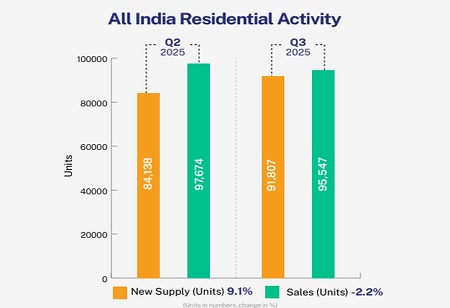
India's real estate sector is poised to reach a milestone of USD 1 trillion by 2030. The market is measured as cautiously optimistic in Q3 2025 with structural stability, policy reform, and shifting buyer sentiment.
While transaction volumes were marginally moderated, fundamentals of the Indian residential real estate remained robust as domestic demand was strong, the sector digitized, and government policies (such as RERA, GST, and Digital India) were implemented.
Supply and Demand: A Delicate Balance
In the third quarter of 2025, new residential supply across India’s eight key cities increased quarter-on-quarter by 9.1 percent to 91,807 units, reassuring developers. Sales fell slightly by 2.2 percent QoQ to 95,547 units and reflected a period of stabilization after several quarters of high growth.
However, while unit volumes fell slightly, the total value of sales increased by 14 percent YoY to Rs. 1.52 lakh crore: another example of premiumization where demand is strongest in the luxury and upper-mid-tier housing segments.
Mumbai, Pune, and Hyderabad accounted for almost 60 percent of new launches, while there was also healthy demand in Bengaluru and Chennai. The premium and luxury categories continued to build unsold inventory, particularly in the Rs. 2–5 crore price brackets, where it increased in stock by 47 percent YoY. That said, the QTS (Quarters-to-Sell) was still healthy at 5.8, or 17.4 months, reflecting an overall balanced market.
India’s residential market in Q3 2025 has demonstrated an impressive ability to sustain momentum … and we may be entering a prolonged plateau phase. - Shishir Baijal, Chairman & MD, Knight Frank India.
 Also Read: Real Estate Influencers and Experts Across India You Must Follow
Also Read: Real Estate Influencers and Experts Across India You Must Follow
Two Key Policy Reforms Reshaped the Q3 of 2025
The first development was the relaxation in taxation. The GST Council lowered tax rates on building materials. Cement dropped from 28 percent to 18 percent, and marble and granite were reduced from 12 percent to 5 percent. This significant policy change is intended to reduce input prices, increase affordability, and improve supply and demand, particularly in the affordable and mid-income areas.
The second development was the proposed Registration Bill 2025, which seeks to repeal the Registration Act of 1908 and replace it with a digital property registration ecosystem, including Aadhaar-based verification of identity and the storage of property registration documents in a central database. The government initiative is intended to bring transparency of ownership, reduce fraud, and enhance buyer confidence in the fast-digitizing real estate sector within a certain government framework.
We use cookies to ensure you get the best experience on our website. Read more...
Copyright © 2025 HomesIndiaMagazine. All Rights Reserved.